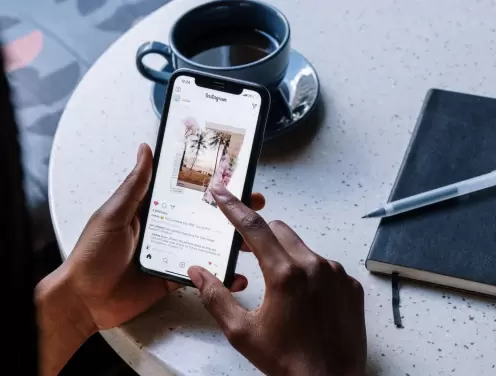Want to master social media image sizes in 2025?
Dive into the ultimate guide for mastering social media image sizes in 2025 and stay ahead of the digital game with platform-specific dimensions and tips to optimize your visuals for maximum engagement. Don't miss out on transforming your social media strategy—click to reveal the secrets professionals use to captivate their audiences!
LEARN MORE LAUNCH DEMO NOW In the ever-evolving world of social media, keeping up with the latest trends and optimal image sizes is as crucial as crafting eye-catching content. As we look ahead to 2025, mastering the art of perfect image dimensions remains vital for enhancing your online presence and engagement. Whether you're a business owner, a marketer, or simply a social media enthusiast, understanding how to align your visuals with platform-specific requirements can significantly boost your content’s performance. This comprehensive guide will delve into the projected social media image sizes for 2025, equipping you with the necessary tools to stay ahead of the curve.
Navigating the digital landscape has always been akin to a moving target, with platforms continuously updating their algorithms, features, and best practices. This makes staying informed about the ideal image sizes not just a matter of aesthetics but also of strategy. With each social media platform catering to its unique user base, each demands specific dimensions to ensure your images look crisp and professional on users' screens. By the end of this article, you'll have a roadmap to optimizing your images efficiently across all major social networks, helping your content not only fit perfectly but also shine brilliantly in 2025 and beyond.
Navigating the digital landscape has always been akin to a moving target, with platforms continuously updating their algorithms, features, and best practices. This makes staying informed about the ideal image sizes not just a matter of aesthetics but also of strategy. With each social media platform catering to its unique user base, each demands specific dimensions to ensure your images look crisp and professional on users' screens. By the end of this article, you'll have a roadmap to optimizing your images efficiently across all major social networks, helping your content not only fit perfectly but also shine brilliantly in 2025 and beyond.
Table of Contents
- Why it's crucial to have proper image sizes?
- How social media platforms determine their image sizes?
- Can the same image size be used across platforms?
- What are common mistakes in choosing the image size?
- How does image size affect your social media engagement?
- What's the optimal image size for each social network?
- Are image sizes likely to change in the future?
- What are the best tools for resizing social media images?
- Ready to elevate your content with perfect image sizes?
Why it's crucial to have proper image sizes?
Having the correct image sizes for social media is crucial because it ensures your content appears professional and captivating across different platforms. Properly sized images prevent unwanted cropping or distortion, which can greatly impact your brand's visual appeal and message delivery. When images display flawlessly, they boost engagement rates, making it easier to catch the eye of your audience and encourage interaction. Plus, using the right dimensions can help optimize your image files, improving load times and enhancing the overall user experience.
How social media platforms determine their image sizes?
Social media platforms determine their image sizes based on a combination of factors aimed at optimizing the user experience and enhancing content visibility. Primarily, these sizes are chosen to ensure that images look crisp and clear on various devices, whether they are smartphones, tablets, or desktops, which have diverse resolutions and screen sizes. By standardizing image dimensions, these platforms can efficiently manage how content is displayed in users’ feeds, reducing loading times and maintaining the platform's aesthetics. Additionally, different types of posts, such as banners, profile pictures, and news feed images, have unique purposes, which is why platforms design specific size requirements to cater to these diverse visual needs.
Another critical aspect in determining image sizes is the platform’s engagement goals and monetization strategies. Platforms often analyze user interaction data to understand what image dimensions enhance user engagement, drive more clicks, or encourage more shares, thereby setting standards that maximize these outcomes. Moreover, platforms regularly update these size guidelines to adapt to evolving trends in social media marketing, where high-impact visuals drive brand storytelling and advertising campaigns. For example, the introduction of video content, stories, and reels has led to innovations in image size recommendations to accommodate dynamic formats. Keeping up with these changes is crucial for content creators and marketers to ensure that their visuals stand out and deliver the intended impact.
Another critical aspect in determining image sizes is the platform’s engagement goals and monetization strategies. Platforms often analyze user interaction data to understand what image dimensions enhance user engagement, drive more clicks, or encourage more shares, thereby setting standards that maximize these outcomes. Moreover, platforms regularly update these size guidelines to adapt to evolving trends in social media marketing, where high-impact visuals drive brand storytelling and advertising campaigns. For example, the introduction of video content, stories, and reels has led to innovations in image size recommendations to accommodate dynamic formats. Keeping up with these changes is crucial for content creators and marketers to ensure that their visuals stand out and deliver the intended impact.
Can the same image size be used across platforms?
When it comes to using the same image size across multiple social media platforms, you'll find that a one-size-fits-all approach typically falls short of providing the best results. Each platform—be it Facebook, Instagram, Twitter, LinkedIn, or Pinterest—has its own specific image size guidelines that are optimized for their respective user interfaces. While using a generic image size like a square 1080x1080 pixels might seem convenient initially, you might end up with cropped, stretched, or poorly displayed images on platforms that require different dimensions. For example, Twitter favors horizontal images for posts, while Instagram Stories require vertical images in a different aspect ratio entirely.
Besides just the technical aspects of image dimensions, you want your visuals to engage and perform well on each platform. Tailoring your images ensures that key elements aren't accidentally cut off, and that your visuals are sharp, clear, and professional-looking. Customizing your images for each platform not only helps achieve optimal visibility but also enhances user engagement by respecting the unique browsing habits associated with each social media channel. Therefore, while it might require a little more effort to prepare platform-specific visuals, the payoff can lead to significantly improved engagement and a more cohesive brand presence across social media.
Besides just the technical aspects of image dimensions, you want your visuals to engage and perform well on each platform. Tailoring your images ensures that key elements aren't accidentally cut off, and that your visuals are sharp, clear, and professional-looking. Customizing your images for each platform not only helps achieve optimal visibility but also enhances user engagement by respecting the unique browsing habits associated with each social media channel. Therefore, while it might require a little more effort to prepare platform-specific visuals, the payoff can lead to significantly improved engagement and a more cohesive brand presence across social media.
What are common mistakes in choosing the image size?
One common mistake in choosing social media image sizes is neglecting platform-specific requirements, which can lead to images being awkwardly cropped or distorted. Another pitfall is using low-resolution images that appear pixelated or blurry, diminishing the quality of your content. Many also overlook the importance of mobile optimization, forgetting that a significant portion of users accesses social media via smartphones and tablets. Lastly, inconsistent sizing across different posts can harm brand aesthetics, making feeds look disjointed and less professional.
How does image size affect your social media engagement?
Image size plays a crucial role in social media engagement by ensuring your content appears crisp and professional across platforms. When your visuals are optimized for each social media platform’s specifications, they load faster and display beautifully, captivating your audience at first glance. On the other hand, oversized images can lead to slow load times and may be cropped awkwardly, causing viewers to lose interest quickly. By mastering the art of image sizing, you ensure that your brand stands out and consistently attracts more likes, shares, and comments.
What's the optimal image size for each social network?
Navigating the ever-changing world of social media can feel like a maze, especially when it comes to mastering image sizes. Each platform has its own unique requirements, and tweaking your images to perfection will ensure that your content shines on every feed. On Facebook, for instance, the optimal image size for shared images is 1200 x 630 pixels, providing a crisp and engaging visual experience for your audience. Instagram, with its emphasis on aesthetics, recommends uploads of 1080 x 1080 pixels for its standard posts to guarantee that every detail of your picture is perfectly preserved.
Delving into Twitter, an image size of 1600 x 900 pixels is optimally set to command attention amidst the swift flow of tweets. LinkedIn, more professionally inclined, suggests a size of 1200 x 627 pixels for posts to maintain slick and professional appearances. Meanwhile, Pinterest's towering portrait pins perform best at 1000 x 1500 pixels, highlighting intricate details and compelling designs. Lastly, let's not forget TikTok, where profile images display best at 200 x 200 pixels, ensuring recognition and a personal touch within their lively ecosystem. Keeping these dimensions in mind not only preserves quality but also amplifies engagement significantly across your social media platforms.
Delving into Twitter, an image size of 1600 x 900 pixels is optimally set to command attention amidst the swift flow of tweets. LinkedIn, more professionally inclined, suggests a size of 1200 x 627 pixels for posts to maintain slick and professional appearances. Meanwhile, Pinterest's towering portrait pins perform best at 1000 x 1500 pixels, highlighting intricate details and compelling designs. Lastly, let's not forget TikTok, where profile images display best at 200 x 200 pixels, ensuring recognition and a personal touch within their lively ecosystem. Keeping these dimensions in mind not only preserves quality but also amplifies engagement significantly across your social media platforms.
Are image sizes likely to change in the future?
As we look forward to 2025, it's quite possible that social media image sizes could change, reflecting the evolving preferences for enhanced visual experiences and new platform features. With technology advancing at a rapid pace, platforms might introduce new dimensions to accommodate immersive and interactive content formats like augmented reality. It's always a good idea to stay adaptable and keep an eye on updates from social media channels to ensure that your content looks its best. Being proactive will help you maintain your competitive edge and engage your audience with vibrant, perfectly sized images.
What are the best tools for resizing social media images?
When it comes to mastering social media image sizes in 2025, having the right tools in your arsenal is essential for ensuring your visuals look flawless across all platforms. Canva continues to be a user-friendly favorite, offering a vast array of pre-sized templates for every social media channel, making the resizing process a breeze. Another great tool is Adobe Spark, which not only allows easy resizing but also offers powerful design features to enhance your images. Let's not forget about Snappa and Crello, two versatile platforms that provide seamless resizing options along with an extensive library of high-quality templates and graphics suitable for any social media need.
Ready to elevate your content with perfect image sizes?
Ready to elevate your content with perfect image sizes? Armed with the knowledge of optimal social media image dimensions, you're now equipped to make a striking visual impact across platforms. Whether you're crafting a stunning Instagram post, a dynamic Facebook cover, or a sleek LinkedIn banner, your images will exude professionalism and style. As we look towards 2025, where visual content reigns supreme, mastering these dimensions is more crucial than ever. Not only will perfectly sized images enhance your brand's credibility, but they will also ensure your content looks polished and appealing, capturing your audience's attention and encouraging engagement.
Remember, the ever-evolving landscape of social media means staying updated is key. Regularly check for updates from your favorite platforms to ensure you’re always using the most accurate dimensions. Consider using tools and resources, like image size guides and editing software, to streamline your process and save valuable time. By prioritizing the right image sizes, you're not just keeping up with trends—you're setting the stage for success. So, dive into this digital world with confidence, and watch your social media presence soar as you make the most of your perfectly tailored visuals.
Remember, the ever-evolving landscape of social media means staying updated is key. Regularly check for updates from your favorite platforms to ensure you’re always using the most accurate dimensions. Consider using tools and resources, like image size guides and editing software, to streamline your process and save valuable time. By prioritizing the right image sizes, you're not just keeping up with trends—you're setting the stage for success. So, dive into this digital world with confidence, and watch your social media presence soar as you make the most of your perfectly tailored visuals.
SOCIAL MEDIA SCHEDULER
Plan and publish...
Plan and publish your content for Facebook, Instagram, Twitter, and LinkedIn from one simple dashboard.
LEARN MORE FREQUENTLY ASKED QUESTIONS
What is social media management platform?
RELATED BLOG POSTS
All the tips & tricks you'll need...
Get the fresh tips and tricks you'll need to ace social media marketing.











